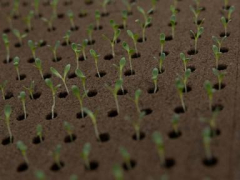SKANEATELES, N.Y. — Farmer Jeremy Brown taps the nose of a young calf. “I love the ones with the pink noses,” he says.
This pink-nosed animal is just one of about 3,200 cattle at Twin Birch Dairy in Skaneateles, New York. In Brown’s eyes, the cows on the farm aren’t just workers: “They’re the boss, they’re the queen of the barn.”
Brown, a co-owner at Twin Birch, is outspoken on the importance of sustainability in his operation. The average dairy cow emits as much as 265 pounds (120 kilograms) of methane, a potent climate-warming gas, each year. Brown says Twin Birch has worked hard to cut its planet-warming emissions through a number of environmentally sound choices.
“Ruminants are the solution, not the problem, to climate change,” he said.
___
EDITOR’S NOTE: This story is a collaboration between Rochester Institute of Technology and The Associated Press.
___
Wearing a weathered hoodie and a hat promoting a brand of cow medicine, Brown was spending a windy Friday morning artificially inseminating some of the farm’s massive Jerseys and Holsteins. He stepped over an electric manure scraper used to clean the animals’ barn.
The electric scraper means the dairy doesn’t have to use a fuel-burning machine for that particular job. Twin Birch also recycles manure for use on crops, cools its milk with water that gets recirculated for cows to drink and grows most of its own feed.
Despite all that, the farm has no desire to pursue a U.S. Department of Agriculture organic certification, Brown said. Doing so would add costs and require the farm to forego technology that makes the dairy business, and ultimately the customer’s jug of milk, more affordable, he said.
He raises a question many farmers have been asking: Is organic farming just a word?
An increasing number of American farmers think so. America’s certified organic acreage fell almost 11% between 2019 and 2021. Numerous farmers who implement sustainable practices told The Associated Press that they have stayed away from the certification because it’s costly, doesn’t do enough to combat climate change and appears to be losing cachet in the marketplace. Converting an existing farm from conventional to organic agriculture can cost tens of thousands of dollars and add labor costs.
The rules governing the National Organic Program were published in 2000, and in the years after, organic farming boomed to eventually reach more than 5 million acres. But that has been declining in recent years.
Any downward trend is significant, as organic farms make up less than 1% of the country’s total





